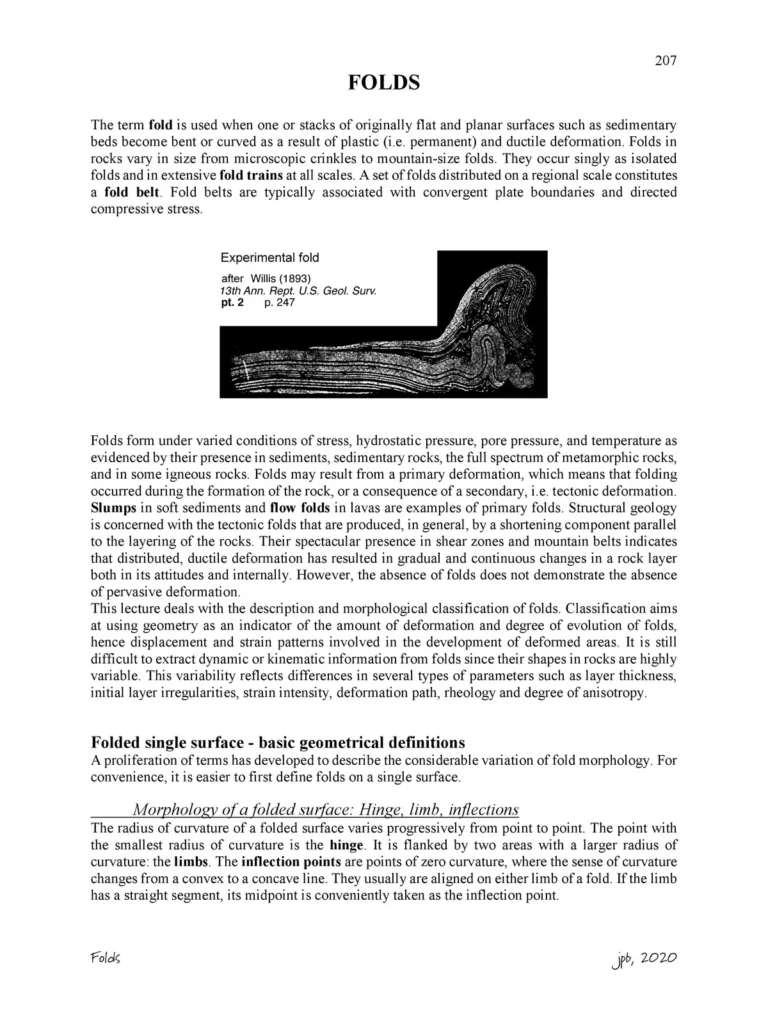Here we provide a direct download link to the ‘Folds Geology PDF In English’. You can find the download button of the attachment pdf at the end of this article. For information, we have provided ‘Folds Geology PDF’ details like PDF size, PDF language, and PDF demo.
Folds Geology Book PDF Free Download

Excerpt From The Book
The term fold is used when one or stacks of originally flat and planar surfaces such as sedimentary beds become bent or curved as a result of plastic (ie. permanent) and ductile deformation.
Folds in rocks vary in size from microscopic crinkles to mountain-size folds. They occur singly as isolated folds and in extensive fold trains at all scales.
A set of folds distributed on a regional scale constitutes a fold belt. Fold belts are typically associated with convergent plate boundaries and directed compressive stress.
The term fold is used when one or stacks of originally flat and planar surfaces such as sedimentary beds become bent or curved as a result of plastic (ie. permanent) and ductile deformation.
Folds in rocks vary in size from microscopic crinkles to mountain-size folds. They occur singly as isolated folds and in extensive fold trains at all scales.
A set of folds distributed on a regional scale constitutes a fold belt. Fold belts are typically associated with convergent plate boundaries and directed compressive stress.
Folded single surface – basic geometrical definitions
A proliferation of terms has developed to describe the considerable variation of fold morphology. For convenience, it is easier to first define folds on a single surface.
FOLDING
Folding is a concept that embraces all geologic processes by which surfaces in rocks become curved during deformation. Since folds are permanent deformation structures with no or little loss of cohesion of the folded layer, folding refers to the essentially slow, ductile behaviour of relatively soft and/or hot rocks.
Beyond the descriptive, anatomical classifications, much of the early geologic work on folding processes focused on the deformation of stratified sediments. Different folding mechanisms combine a few basic processes involving the geometrical (layer thickness and spacing) and physical (viscosity, viscosity contrast, anisotropy) properties of the rocks.
This lecture deals with some consideration on genetic, and mechanical aspects concerning the development of folds. The important point to note is that stress alone is insufficient to cause folding: A planar surface must first exist to define the fold shape, and the orientation of this planar marker with respect to the stress direction controls in many ways the attitude of the resulting fold.
Folding processes
Most models of fold formation ignore body forces and the effect of the material enclosing the layers(both are treated as viscous fluids), which in practice has a very important role in determining or modifying the fold geometry. Flat layers may become curved in several ways.
Rotation
Obviously, folding rotates parts of the layers. The continuous change in orientation of the stiff layers with respect to the shortening direction first produces a marked decrease in the compressive resistance of the rock mass.
This is a form of bulk weakening, which accompanies the progressive modification of the internal geometry of the rock mass without any change in material properties (e.g. viscosity); it is accordingly termed structural softening.
Structural softening is followed by an increase in compressive resistance, structural hardening. Softening and hardening are the conditions for onset, growth and decay of instabilities.
Evidently, any other mechanism of strain softening that may be present (e.g. a change in the effective material properties caused by processes such as microfracturing, pressure solution, etc…) will also affect the stability of the system.
Lengthening
Fold hinges most often mark the site where the folds began to amplify. This is usually over a short distance so that any fold axis plunges towards the two extremities of the hinge segment. Further limb rotation and subsequent fold growth (amplification) accompanies lengthwise, not necessarily symmetrical migration of the hinge tips.
Mechanical role of layers: Active / passive folding
Any deformation involves displacement of material points, for example particles. A passive particle
has no interaction with its neighbours; it only moves.
An active particle interacts with its neighbours and its displacement is affected by that of neighbouring particles.
In geology, the compositional layering has mechanical properties influencing the strain pattern and
the folding process. For example, boundaries between layers with contrasting strengths (viscosity)
may slip or localise shear deformation, hence guiding the way curvatures develop.
Folding is active
when deformation takes place at the layer scale and the strength difference between layers directly affects the deformation pattern. Conversely, passive folding takes place at the grain scale while layers have no significant competence contrasts and so do not generate any stress acting across and/or parallel to the layer boundaries; layering serves merely as a geometrical strain marker.
Passive folds
grow during heterogeneous flow and their shape reflects the pattern of heterogeneous deformation. Passive folding is experimented by folding a stack of modelling-paste layers (think also of oil traces or scum on slowly flowing water). Active folding is experimented by bending a pile of cards that glide one upon the other.
| Author | – |
| Language | English |
| Pages | 28 |
| PDF Size | 6.33 MB |
| Category | Geography |
Folds Geology Book PDF Free Download